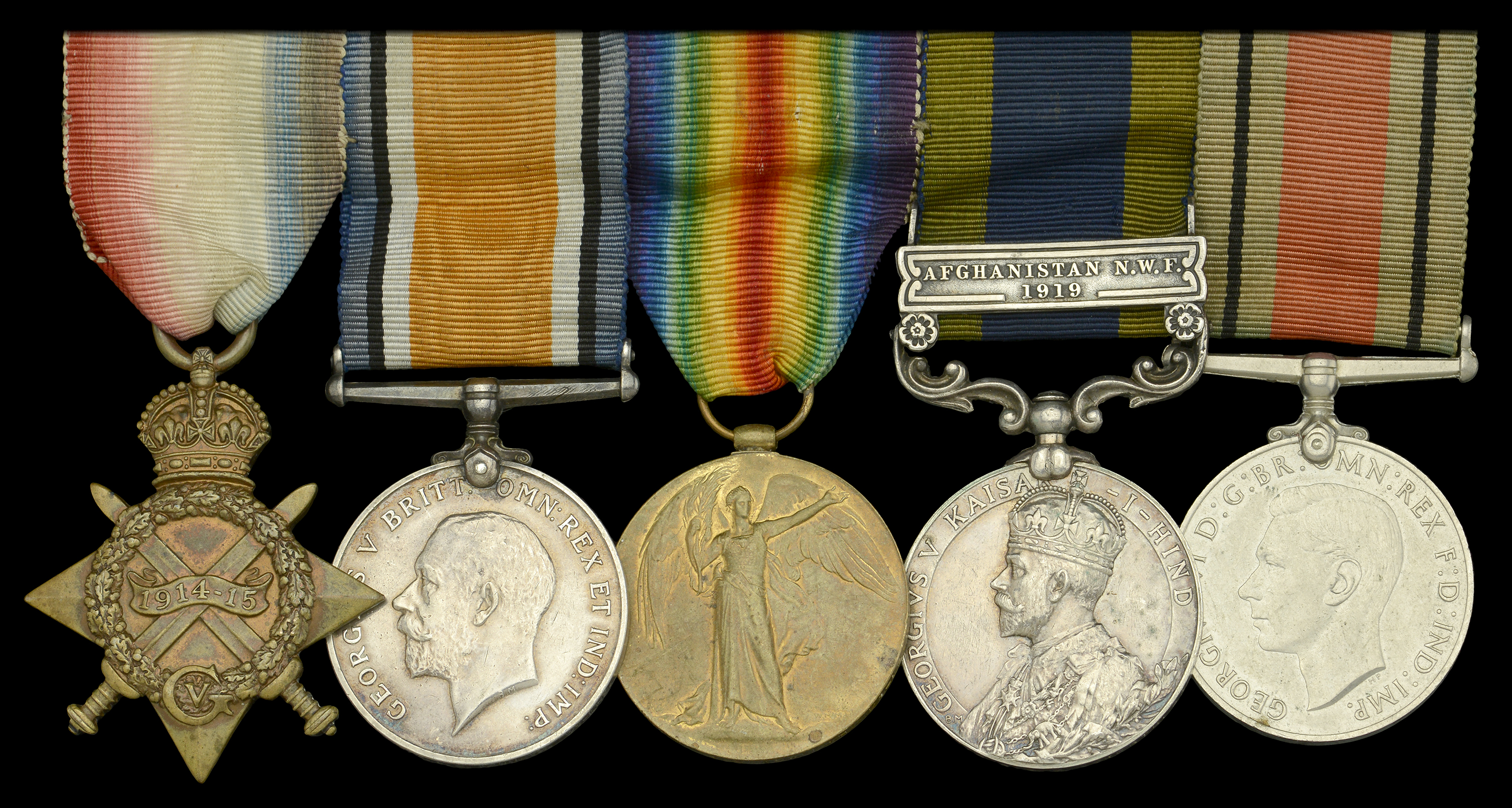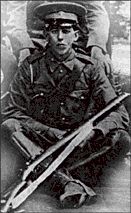14
Five: Private E. A. S. Isworth, 21st Lancers, who was wounded in the regiment's celebrated...
Bids do not include VAT, buyer’s premium or delivery.
By confirming your bid, you agree that you have read and accepted the-saleroom.com and the auctioneer's terms and conditions. Confirming your bid is a legally binding obligation to purchase and pay for the lot should your bid be successful.
Choose one of the quick bid options below:
Bids do not include VAT, buyer’s premium or delivery.
By confirming your bid, you agree that you have read and accepted the-saleroom.com and the auctioneer's terms and conditions. Confirming your bid is a legally binding obligation to purchase and pay for the lot should your bid be successful.
1914-15 Star (L-2417. Pte. E. A. S. Isworth, 21st. Lrs.); British War and Victory Medals (L-2417 Pte. E. A. S. Isworth. 21-Lrs.); India General Service 1908-35, 1 clasp, Afghanistan N.W.F. 1919 (L-20311 Pte. E. A. S. Isworth. 21 Lrs.); Defence Medal, mounted as worn, generally very fine (5) £400-£500
---
Provenance: Tom Gustard Collection, Dix Noonan Webb, December 2006.
Edward Angus Sinclair Isworth was born on 20 October 1891 and attested for the 21st Lancers. He served with them during the Great War on the Frontier Regions of India, and is confirmed as having been wounded in the regiment’s famous charge at Shabkadar in the 21st Lancers’ regimental journal, The Vedette.
Moreover, it was reported in the same publication in 1991 - by then retitled The White Lancer and The Vedette - that the oldest survivor of the regiment, Charles Albert Wildman, himself a casualty on that fateful day at Shabkadar in September 1915, had recently celebrated his 100th birthday - and was a friend of Isworth:
‘He [Wildman] was present during the action in 1915 where Lieutenant-Colonel Scriven and Captain Anderson, his Commanding Officer and Squadron Leader, were killed. He recalls setting up a heliograph on some high ground, promptly being shot at and having his horse shot from under him, recovering his rifle, sword and lance and being picked up by a friend Angus Insworth. He in his turn noticed that his friend was suffering from a wound to his arm, administered first aid and returned him to the regimental Aid Post. He was also wounded himself when a shell from ‘M’ Battery fell 100 yards short, wounding him in the rear.’
Isworth’s wounds would appear to have been quite serious, ‘C’ Squadron records noting that he was transferred for further treatment at Pindi as late as December 1915. Recovering, he saw further service during the Third Afghan War. He died in Wembley, Middlesex, on 1 December 1962.
Sold with copied research.
1914-15 Star (L-2417. Pte. E. A. S. Isworth, 21st. Lrs.); British War and Victory Medals (L-2417 Pte. E. A. S. Isworth. 21-Lrs.); India General Service 1908-35, 1 clasp, Afghanistan N.W.F. 1919 (L-20311 Pte. E. A. S. Isworth. 21 Lrs.); Defence Medal, mounted as worn, generally very fine (5) £400-£500
---
Provenance: Tom Gustard Collection, Dix Noonan Webb, December 2006.
Edward Angus Sinclair Isworth was born on 20 October 1891 and attested for the 21st Lancers. He served with them during the Great War on the Frontier Regions of India, and is confirmed as having been wounded in the regiment’s famous charge at Shabkadar in the 21st Lancers’ regimental journal, The Vedette.
Moreover, it was reported in the same publication in 1991 - by then retitled The White Lancer and The Vedette - that the oldest survivor of the regiment, Charles Albert Wildman, himself a casualty on that fateful day at Shabkadar in September 1915, had recently celebrated his 100th birthday - and was a friend of Isworth:
‘He [Wildman] was present during the action in 1915 where Lieutenant-Colonel Scriven and Captain Anderson, his Commanding Officer and Squadron Leader, were killed. He recalls setting up a heliograph on some high ground, promptly being shot at and having his horse shot from under him, recovering his rifle, sword and lance and being picked up by a friend Angus Insworth. He in his turn noticed that his friend was suffering from a wound to his arm, administered first aid and returned him to the regimental Aid Post. He was also wounded himself when a shell from ‘M’ Battery fell 100 yards short, wounding him in the rear.’
Isworth’s wounds would appear to have been quite serious, ‘C’ Squadron records noting that he was transferred for further treatment at Pindi as late as December 1915. Recovering, he saw further service during the Third Afghan War. He died in Wembley, Middlesex, on 1 December 1962.
Sold with copied research.
Orders, Decorations, Medals and Militaria
Sale Date(s)
Venue Address
General delivery information available from the auctioneer
If you are successful in purchasing lot/s being auctioned by us and opt for the item/s to be sent to you, we will use the following methods of shipment:
Within the UK
If you live within the UK, items will be despatched using Royal Mail Special Delivery. This service provides parcel tracking (via the Royal Mail website) and next weekday delivery (betwen 9am and 1pm). Items delivered within the UK are covered by our insurance company. Heavy and bulky lots will be sent by courier, in discussion with the client.
Outside of the UK
If the item/s being sent are worth under £1000 in total they are sent using Royal Mail’s Signed For International service. This ensures the item must be signed for when it is delivered.
If the item/s being sent are valued at over £1000 in total they will be sent using FedEx. This service allows next day delivery to customers in many parts of the US and parcels are fully trackable using the FedEx website.
Shipping Exceptions
Certain lots such as those containing glass or sharp implements, etc., may not be suitable for in-house shipping within or outside of the UK. Please contact Noonans with any queries.
Important Information
Auctioneer's Buyers Premium: 24% (+VAT)
There is an additional charge of 4.95% (+VAT/sales tax)














